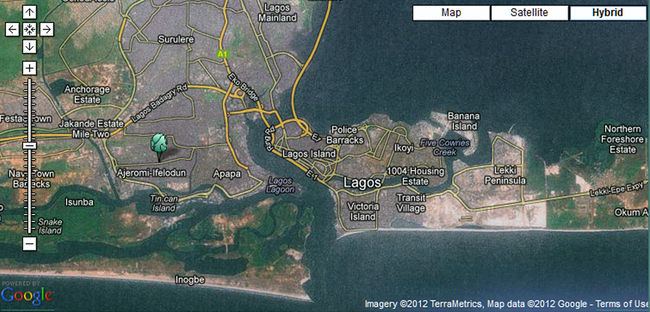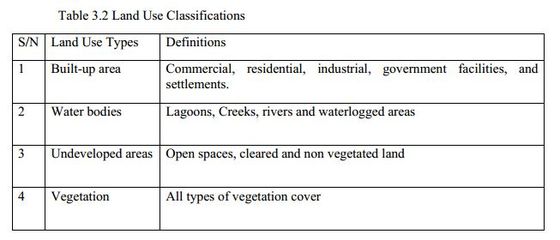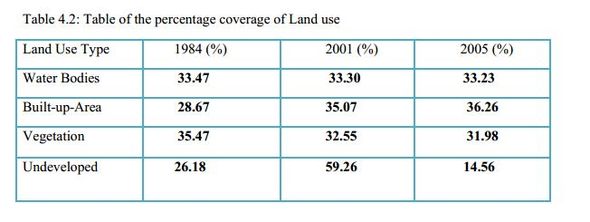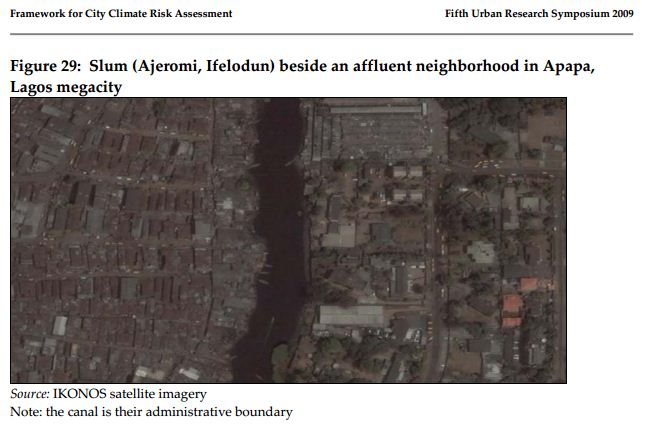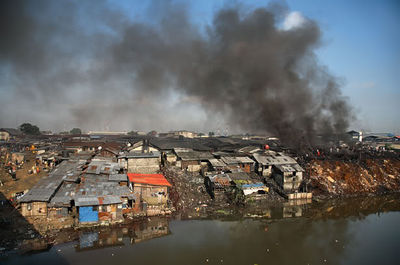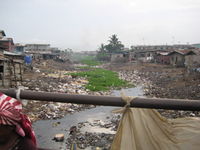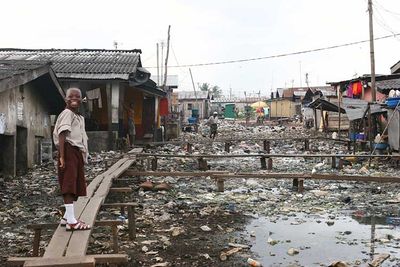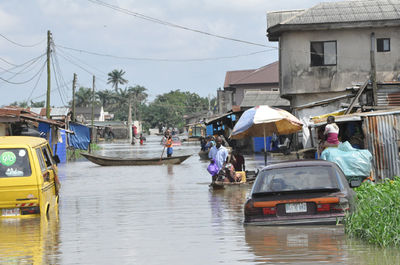Group B - Collaborative Climate Adaption Project: Difference between revisions
Kingajanossy (talk | contribs) |
No edit summary |
||
| Line 70: | Line 70: | ||
* Climate change is now generally recognized as the greatest challenge to sustainable development, especially in a developing country such as Nigeria. Lagos State is particularly vulnerable to the impacts of climate change and unless concerted and urgent action is taken, it could result in widespread ecosystem degradation, thus disrupting socio-economic development and the welfare of the people. (Towards a Lagos State Climate Change Adaptation Strategy, 2012) | * Climate change is now generally recognized as the greatest challenge to sustainable development, especially in a developing country such as Nigeria. Lagos State is particularly vulnerable to the impacts of climate change and unless concerted and urgent action is taken, it could result in widespread ecosystem degradation, thus disrupting socio-economic development and the welfare of the people. (Towards a Lagos State Climate Change Adaptation Strategy, 2012) | ||
* In Lagos State, impoverished coastal communities living on reclaimed land are at risk from flooding due to storm surges and heavy rainfall events. Residents in these communities cope with impacts such as property damage, temporary homelessness, and spread of malaria. In this case, future vulnerability will be affected by rising sea levels and increased severity of storms expected in a changing climate, which will significantly affect urban development patterns. (Adelekan, 2009) | * In Lagos State, impoverished coastal communities living on reclaimed land are at risk from flooding due to storm surges and heavy rainfall events. Residents in these communities cope with impacts such as property damage, temporary homelessness, and spread of malaria. In this case, future vulnerability will be affected by rising sea levels and increased severity of storms expected in a changing climate, which will significantly affect urban development patterns. (Adelekan, 2009) | ||
* The study area is set in Ajegunle, it is located in Ajeromi Ifelodun (local government area of Lagos state, Nigeria). The site is a major informal settlement, often described as ‘jungle city’ with a multi-ethnic population. It is evident that decent housing is a major problem of informal settlement dwellers. This is largely due to their low level of financial capacity coupled with inefficient land administration system which have further exclude them from urban life and increased their vulnerability to eviction, disaster and environmental health problem. Therefore, any attempt to achieve livable, healthy and prosper cities must as a matter of urgency address housing issue. This means that there must be a conscious effort focusing on provision of decent housing for the poor at an affordable rate. | * The study area is set in Ajegunle, it is located in Ajeromi Ifelodun (local government area of Lagos state, Nigeria). The site is a major informal settlement, often described as ‘jungle city’ with a multi-ethnic population. It is evident that decent housing is a major problem of informal settlement dwellers. This is largely due to their low level of financial capacity coupled with inefficient land administration system which have further exclude them from urban life and increased their vulnerability to eviction, disaster and environmental health problem. Therefore, any attempt to achieve livable, healthy and prosper cities must as a matter of urgency address housing issue. This means that there must be a conscious effort focusing on provision of decent housing for the poor at an affordable rate. | ||
[[File:Lagos_state.JPG|300px|thumb|right|Map of Lagos State]] | |||
=== Authors' perspectives === | === Authors' perspectives === | ||
| Line 89: | Line 92: | ||
* Lagos is the most populous city in Nigeria, the largest country in Africa. The metropolitan area, an estimated 300 square kilometers, is a group of islands endowed with creeks and a lagoon. Lagos is projected to be one of the world's five largest cities by 2005. In an effort to reduce massive urbanization in the metropolitan area, the Federal Government is in the process of moving the capital to Abuja. | * Lagos is the most populous city in Nigeria, the largest country in Africa. The metropolitan area, an estimated 300 square kilometers, is a group of islands endowed with creeks and a lagoon. Lagos is projected to be one of the world's five largest cities by 2005. In an effort to reduce massive urbanization in the metropolitan area, the Federal Government is in the process of moving the capital to Abuja. | ||
[[File:Ajegunle.jpg|650px|thumb|left|Ajegunle in Lagos, Nigeria]] | |||
* Energy and water access, sewerage, transportation and housing have all been adversely affected by haphazard development of a geographically disjointed city. Unlike the rest of Nigeria, 90% of the population of Lagos have access to electricity, with the city consuming 45% of the energy of the country. Despite the region's endowment of water, the city suffers from an acute and worsening water supply shortage. And due to inadequate sewerage, much the city's human waste is disposed of by the drainage of rainwater through open ditches that discharge onto the tidal flats. | * Energy and water access, sewerage, transportation and housing have all been adversely affected by haphazard development of a geographically disjointed city. Unlike the rest of Nigeria, 90% of the population of Lagos have access to electricity, with the city consuming 45% of the energy of the country. Despite the region's endowment of water, the city suffers from an acute and worsening water supply shortage. And due to inadequate sewerage, much the city's human waste is disposed of by the drainage of rainwater through open ditches that discharge onto the tidal flats. | ||
| Line 94: | Line 99: | ||
* Since 1985, state urban renewal plans have concentrated on upgrading the environment of slum communities by building roads and drainage channels and providing water supply, electricity, schools and health clinics. With cooperation from the citizens, success has been recorded in a number of pilot urban renewal schemes, which focus on building roads and drainage channels and providing water supply, electricity, schools and health clinics. (The Challenge of Urbanization: The World's Largest Cities, UN Publications) | * Since 1985, state urban renewal plans have concentrated on upgrading the environment of slum communities by building roads and drainage channels and providing water supply, electricity, schools and health clinics. With cooperation from the citizens, success has been recorded in a number of pilot urban renewal schemes, which focus on building roads and drainage channels and providing water supply, electricity, schools and health clinics. (The Challenge of Urbanization: The World's Largest Cities, UN Publications) | ||
* GIS revealed a drastic expansion of developed areas in Lagos leading to a rapid loss of biodiversity and other forms of environmental degradation. This uncoordinated growth resulted into a mosaic of shanties/ blighted areas in many older areas of the city; Poorly serviced areas in terms of urban infrastructures such as roads, health centers, police stations, electricity, water, drainage systems, waste management, etc. (Rural-urban migration, poverty and sustainable environment: the case of Lagos, Nigeria prof. Peter ‘Bola Okuneye) | * GIS revealed a drastic expansion of developed areas in Lagos leading to a rapid loss of biodiversity and other forms of environmental degradation. This uncoordinated growth resulted into a mosaic of shanties/ blighted areas in many older areas of the city; Poorly serviced areas in terms of urban infrastructures such as roads, health centers, police stations, electricity, water, drainage systems, waste management, etc. (Rural-urban migration, poverty and sustainable environment: the case of Lagos, Nigeria prof. Peter ‘Bola Okuneye) | ||
| Line 99: | Line 107: | ||
* In Ajegunle, over 70% of the buildings in the area are Brazilian type while 13.1% of the buildings in Ajegunle are traditional compound type and 9.2% are flat. It is not surprising that most of the building are Brazilian (face me and face you) buildings or rooming apartment because it is believed to be the main design and characteristics of low income group as well as poor communities in Nigeria cities. Most of the buildings (50.3%) are predominantly residential however, a significant proportion representing 40.5% of the buildings are mixed use while other land uses account for 9.2%. | * In Ajegunle, over 70% of the buildings in the area are Brazilian type while 13.1% of the buildings in Ajegunle are traditional compound type and 9.2% are flat. It is not surprising that most of the building are Brazilian (face me and face you) buildings or rooming apartment because it is believed to be the main design and characteristics of low income group as well as poor communities in Nigeria cities. Most of the buildings (50.3%) are predominantly residential however, a significant proportion representing 40.5% of the buildings are mixed use while other land uses account for 9.2%. | ||
* About 85.9% of the buildings are accessible by roads but, the main problem is that majority of the roads are not tarred and the conditions are extremely poor. The roads are characterized by poor drainage, lack of street lighting, absence of pedestrian walkway as well as on street parking. Also some of the roads are used as refuse dump site. | * About 85.9% of the buildings are accessible by roads but, the main problem is that majority of the roads are not tarred and the conditions are extremely poor. The roads are characterized by poor drainage, lack of street lighting, absence of pedestrian walkway as well as on street parking. Also some of the roads are used as refuse dump site. | ||
* Aptly named, the Dustbin Estate is a collection of shanties on refuse dump where a very poor set of people live in Ajegunle. Living on a large heap of rubbish poses a myriad of health hazards to both adults and the children, not neglecting the attendant environmental issues. Whenever there is rainfall, the situation is worsened as the entire ‘estate’ is soaked in flood and people still go about their normal duties in this deplorable state. One wonders how these people survive; they eat, drink, have their bath, sleep, talk and do virtually everything in this ever-smelly settlement. Some of them make money from charging people who dispose their refuse here, but one wonders if the 50 Naira note collected for each pack of refuse could ever sum up to justify and alleviate the prevalent abject poverty and hazardous living. | * Aptly named, the Dustbin Estate is a collection of shanties on refuse dump where a very poor set of people live in Ajegunle. Living on a large heap of rubbish poses a myriad of health hazards to both adults and the children, not neglecting the attendant environmental issues. Whenever there is rainfall, the situation is worsened as the entire ‘estate’ is soaked in flood and people still go about their normal duties in this deplorable state. One wonders how these people survive; they eat, drink, have their bath, sleep, talk and do virtually everything in this ever-smelly settlement. Some of them make money from charging people who dispose their refuse here, but one wonders if the 50 Naira note collected for each pack of refuse could ever sum up to justify and alleviate the prevalent abject poverty and hazardous living. | ||
| Line 109: | Line 115: | ||
[[File:Classifications.JPG|560px|left]] [[File:Percentage.JPG|590px|right]] | [[File:Classifications.JPG|560px|left]] [[File:Percentage.JPG|590px|right]] | ||
[[File:Slum.JPG]] | [[File:Slum.JPG]] | ||
(Land Use Change Analyses in Lagos State From 1984 to 2005/Oludayo Emmanuel ABIODUN, James Bolarinwa OLALEYE, Andrew Nnamdi DOKAI and Adedayo Kazeem ODUNAIYA, Nigeria) | (Land Use Change Analyses in Lagos State From 1984 to 2005/Oludayo Emmanuel ABIODUN, James Bolarinwa OLALEYE, Andrew Nnamdi DOKAI and Adedayo Kazeem ODUNAIYA, Nigeria) | ||
=== Cultural/social/political context=== | === Cultural/social/political context=== | ||
* Lagos is a city and chief port in Lagos state, Nigeria. Until 1975 it was the capital of Lagos state, and until December 1991 it was the federal capital of Nigeria. Ikeja replaced Lagos as the state capital, and Abuja replaced Lagos as the federal capital. Lagos, however, remained the unofficial seat of many government agencies. The city’s population is centered on Lagos Island, in Lagos Lagoon, on the Bight of Benin in the Gulf of Guinea. Lagos is Nigeria’s largest city and one of the largest in sub-Saharan Africa. | * Lagos is a city and chief port in Lagos state, Nigeria. Until 1975 it was the capital of Lagos state, and until December 1991 it was the federal capital of Nigeria. Ikeja replaced Lagos as the state capital, and Abuja replaced Lagos as the federal capital. Lagos, however, remained the unofficial seat of many government agencies. The city’s population is centered on Lagos Island, in Lagos Lagoon, on the Bight of Benin in the Gulf of Guinea. Lagos is Nigeria’s largest city and one of the largest in sub-Saharan Africa. | ||
| Line 170: | Line 177: | ||
=== Climate of Lagos === | === Climate of Lagos === | ||
* What are the climatic conditions at present? Have there been extreme weather events in the near past? | * What are the climatic conditions at present? Have there been extreme weather events in the near past? | ||
| Line 180: | Line 188: | ||
[[File:Avarage.JPG]] | [[File:Avarage.JPG]] | ||
=== Climate of Ajegunle === | === Climate of Ajegunle === | ||
[[File:Temp_ajegunle.jpeg]] [[File:Temperature_ajelunge.jpeg]] | [[File:Temp_ajegunle.jpeg]] [[File:Temperature_ajelunge.jpeg]] | ||
* As a clear evidence of climate change, rainstorms affects Ajegunle community. Heaven were let loose when unpredictable rainstorm hit Ajegunle houses due to climate change. Speaking to Isokotoday, one of the victims who resides at No 12 Ijaiye street whose house roof was blow off, Mr Samuel Bassey said at about 5am, when I was praying i saw little rain falling but never has the premonition that rainstorm will follow.Within a twinkle of an eye,my roof was off. It was a pathetic experience in my life,he said. Another victim who pleaded on the condition of anonymity said that the abandoned Ajeromi primary school at Sanusi street where my children used to attend was greatly affected by the rainstorm disaster. ''I was sleeping when I heard a terrible noise thinking it was another plane mishap only to discover that it was another rainstorm disaster. We thank God no live was lost.'' The Chairman of Ajeromi-Ifelodun Hon Bayewu Kamal who visited the scene told victims of the affected houses not to worry that he will inform Lagos State Governor on the next line of action. (GODDAY ODIDI, Thursday, June 07, 2012) | * As a clear evidence of climate change, rainstorms affects Ajegunle community. Heaven were let loose when unpredictable rainstorm hit Ajegunle houses due to climate change. Speaking to Isokotoday, one of the victims who resides at No 12 Ijaiye street whose house roof was blow off, Mr Samuel Bassey said at about 5am, when I was praying i saw little rain falling but never has the premonition that rainstorm will follow.Within a twinkle of an eye,my roof was off. It was a pathetic experience in my life,he said. Another victim who pleaded on the condition of anonymity said that the abandoned Ajeromi primary school at Sanusi street where my children used to attend was greatly affected by the rainstorm disaster. ''I was sleeping when I heard a terrible noise thinking it was another plane mishap only to discover that it was another rainstorm disaster. We thank God no live was lost.'' The Chairman of Ajeromi-Ifelodun Hon Bayewu Kamal who visited the scene told victims of the affected houses not to worry that he will inform Lagos State Governor on the next line of action. (GODDAY ODIDI, Thursday, June 07, 2012) | ||
=== Analysis of vulnerability === | === Analysis of vulnerability === | ||
* The topography of Lagos is dominated by its system of islands, sandbars, and lagoons. The city itself sprawls over four main islands: Lagos, Iddo, Ikoyi, and Victoria, which are connected to each other and to the mainland by a system of bridges. All the territory is low-lying, the highest point on Lagos Island being only 22 feet (7 meters) above sea level, and the average height in Lagos is 5 meters above sea level. | * The topography of Lagos is dominated by its system of islands, sandbars, and lagoons. The city itself sprawls over four main islands: Lagos, Iddo, Ikoyi, and Victoria, which are connected to each other and to the mainland by a system of bridges. All the territory is low-lying, the highest point on Lagos Island being only 22 feet (7 meters) above sea level, and the average height in Lagos is 5 meters above sea level. | ||
| Line 202: | Line 215: | ||
=== Proposals for Climate Change Adaption === | === Proposals for Climate Change Adaption === | ||
* How could your case study area become more resilient to climate change? | * How could your case study area become more resilient to climate change? | ||
| Line 212: | Line 226: | ||
=== Proposals for Climate Change Mitigation === | === Proposals for Climate Change Mitigation === | ||
* Plant trees to reduce greenhouse gas emissions and create water absorption on the ground. | * Plant trees to reduce greenhouse gas emissions and create water absorption on the ground. | ||
| Line 225: | Line 241: | ||
=== Your scenario === | === Your scenario === | ||
*How will this area look like in 2060? | *How will this area look like in 2060? | ||
| Line 237: | Line 254: | ||
=== What can be generalized from this case study? === | === What can be generalized from this case study? === | ||
*Are there any important theoretical insights? | *Are there any important theoretical insights? | ||
Revision as of 09:47, 15 January 2013
- Back to working group overview
| Area | Ajegunle | |
| Place | Lagos state | |
| Country | Nigeria | |
| Topic | Climate Change Impacts on Coastal Settlements | |
| Author(s) | Kinga Jánossy, Melissa Abas and Fadera Williams | |

| ||
|
| ||
Rationale: Why have you selected this case study area?
- Climate change is now generally recognized as the greatest challenge to sustainable development, especially in a developing country such as Nigeria. Lagos State is particularly vulnerable to the impacts of climate change and unless concerted and urgent action is taken, it could result in widespread ecosystem degradation, thus disrupting socio-economic development and the welfare of the people. (Towards a Lagos State Climate Change Adaptation Strategy, 2012)
- In Lagos State, impoverished coastal communities living on reclaimed land are at risk from flooding due to storm surges and heavy rainfall events. Residents in these communities cope with impacts such as property damage, temporary homelessness, and spread of malaria. In this case, future vulnerability will be affected by rising sea levels and increased severity of storms expected in a changing climate, which will significantly affect urban development patterns. (Adelekan, 2009)
- The study area is set in Ajegunle, it is located in Ajeromi Ifelodun (local government area of Lagos state, Nigeria). The site is a major informal settlement, often described as ‘jungle city’ with a multi-ethnic population. It is evident that decent housing is a major problem of informal settlement dwellers. This is largely due to their low level of financial capacity coupled with inefficient land administration system which have further exclude them from urban life and increased their vulnerability to eviction, disaster and environmental health problem. Therefore, any attempt to achieve livable, healthy and prosper cities must as a matter of urgency address housing issue. This means that there must be a conscious effort focusing on provision of decent housing for the poor at an affordable rate.
Authors' perspectives
- Climate change is not only an environmental challenge but also social, health, economic and viability matter. While Africa comparatively contribute less (emitting less than 3% GHG global emissions; Ogunlade, 2008) to global warming, it is by far the most vulnerable to its effects as it lacks capability in terms of infrastructure, technology, social and the economy to resist or manage disasters such as storm, drought, flood, land slide, etc. which are associated with global warming and climate change. (Climate change and coastal states dialogue, 2012) As landscape architects we should provide adaptation strategies with interdisciplinary approaches to improve sustainable urban planning in order to preserve the natural and human life.
Landscape and/or urban context
- Lagos is the most populous city in Nigeria, the largest country in Africa. The metropolitan area, an estimated 300 square kilometers, is a group of islands endowed with creeks and a lagoon. Lagos is projected to be one of the world's five largest cities by 2005. In an effort to reduce massive urbanization in the metropolitan area, the Federal Government is in the process of moving the capital to Abuja.
- Energy and water access, sewerage, transportation and housing have all been adversely affected by haphazard development of a geographically disjointed city. Unlike the rest of Nigeria, 90% of the population of Lagos have access to electricity, with the city consuming 45% of the energy of the country. Despite the region's endowment of water, the city suffers from an acute and worsening water supply shortage. And due to inadequate sewerage, much the city's human waste is disposed of by the drainage of rainwater through open ditches that discharge onto the tidal flats.
- Since 1985, state urban renewal plans have concentrated on upgrading the environment of slum communities by building roads and drainage channels and providing water supply, electricity, schools and health clinics. With cooperation from the citizens, success has been recorded in a number of pilot urban renewal schemes, which focus on building roads and drainage channels and providing water supply, electricity, schools and health clinics. (The Challenge of Urbanization: The World's Largest Cities, UN Publications)
- GIS revealed a drastic expansion of developed areas in Lagos leading to a rapid loss of biodiversity and other forms of environmental degradation. This uncoordinated growth resulted into a mosaic of shanties/ blighted areas in many older areas of the city; Poorly serviced areas in terms of urban infrastructures such as roads, health centers, police stations, electricity, water, drainage systems, waste management, etc. (Rural-urban migration, poverty and sustainable environment: the case of Lagos, Nigeria prof. Peter ‘Bola Okuneye)
- In Ajegunle, over 70% of the buildings in the area are Brazilian type while 13.1% of the buildings in Ajegunle are traditional compound type and 9.2% are flat. It is not surprising that most of the building are Brazilian (face me and face you) buildings or rooming apartment because it is believed to be the main design and characteristics of low income group as well as poor communities in Nigeria cities. Most of the buildings (50.3%) are predominantly residential however, a significant proportion representing 40.5% of the buildings are mixed use while other land uses account for 9.2%.
- About 85.9% of the buildings are accessible by roads but, the main problem is that majority of the roads are not tarred and the conditions are extremely poor. The roads are characterized by poor drainage, lack of street lighting, absence of pedestrian walkway as well as on street parking. Also some of the roads are used as refuse dump site.
- Aptly named, the Dustbin Estate is a collection of shanties on refuse dump where a very poor set of people live in Ajegunle. Living on a large heap of rubbish poses a myriad of health hazards to both adults and the children, not neglecting the attendant environmental issues. Whenever there is rainfall, the situation is worsened as the entire ‘estate’ is soaked in flood and people still go about their normal duties in this deplorable state. One wonders how these people survive; they eat, drink, have their bath, sleep, talk and do virtually everything in this ever-smelly settlement. Some of them make money from charging people who dispose their refuse here, but one wonders if the 50 Naira note collected for each pack of refuse could ever sum up to justify and alleviate the prevalent abject poverty and hazardous living.
(Land Use Change Analyses in Lagos State From 1984 to 2005/Oludayo Emmanuel ABIODUN, James Bolarinwa OLALEYE, Andrew Nnamdi DOKAI and Adedayo Kazeem ODUNAIYA, Nigeria)
Cultural/social/political context
- Lagos is a city and chief port in Lagos state, Nigeria. Until 1975 it was the capital of Lagos state, and until December 1991 it was the federal capital of Nigeria. Ikeja replaced Lagos as the state capital, and Abuja replaced Lagos as the federal capital. Lagos, however, remained the unofficial seat of many government agencies. The city’s population is centered on Lagos Island, in Lagos Lagoon, on the Bight of Benin in the Gulf of Guinea. Lagos is Nigeria’s largest city and one of the largest in sub-Saharan Africa.
- By the late 15th century Lagos Island had been settled by Yoruba fishermen and hunters, who called it Oko. The area was dominated by the kingdom of Benin, which called it Eko, from the late 16th century to the mid-19th century. The Portuguese first landed on Lagos Island in 1472; trade developed slowly, however, until the Portuguese were granted a slaving monopoly a century later. The local obas (kings) enjoyed good relations with the Portuguese, who called the island Onim (and, later, Lagos) and who established a flourishing slave trade. British attempts to suppress the slave trade culminated in 1851 in a naval attack on Lagos and the deposition of the oba. The slave trade continued to grow, however, until Lagos came under British control in 1861.
- Originally governed as a British crown colony, Lagos was part of the United Kingdom’s West African Settlements from 1866 to 1874, when it became part of the Gold Coast Colony (modern Ghana). In 1886 it again achieved separate status under a British governor, and in 1906 it was amalgamated with the Protectorate of Southern Nigeria. When Southern and Northern Nigeria were amalgamated in 1914, Lagos was made the capital of the Colony and Protectorate of Nigeria. In 1954 most of the hinterland was incorporated into the region of Western Nigeria, while the city itself was designated as federal territory. In 1960 Lagos became the capital of independent Nigeria. Control of its hinterland was returned to the city in 1967 with the creation of Lagos state. After 1975 a new national capital, centrally situated near Abuja, was developed to replace Lagos, which by then suffered from slums, environmental pollution, and traffic congestion.(Encyclopædia Britannica, 2002)
- Ajegunle has a population density of 7,941/km2, which is the highest populated of all slums in Lagos state. The slum area of Ajegunle constitutes 12.8% of the total area of all 42 blighted areas as at 1995. According to Stoveland Consult, WTP Study of 1997, majority of the multi-ethnic population of Ajegunle are of school age and highly, economically productive. Ajegunle is made up of five resident communities, and consist of people from all parts of the country with the dominant groups being the Ijaw, Ilaje, Hausa, Ibo, Urhobo and Yoruba ethnicity. Their main occupation is trading in the formal and informal sectors.
- Ajegunle falls under the Badagry Division. Major settlements in this Division include: Badagry, Ajara, Iworo-Ajido, Akarakumo, Gbaji, Aseri, Egan, Agarin, Ahanfe, Epe, Posi, Mowo, Itoga, Ebiri, Ekunpa, Aradagun, Berekete, Mosafejo, Gayingbo-Topo, Kankon, Moba, Popoji, Oranyan, Tafi-Awori, Yeketome, Ipota, Seme, Iyagbe, Ajegunle, Aiyetoro, Festac and Satellite Towns, Iba, Kirikiri, Agboju-Amuwo, Okokomaiko, Ojo, Amukoko, Alaba-ore, Ijofin, Igbanko, Imore, Ijegun, Odan Group of villages and part of Agara.
- The Lagos metropolitan area is also a major educational and cultural centre. The University of Lagos (1962), the National Library, the Lagos City Libraries, and the National Museum (1957), with excellent historical examples of Nigerian arts and crafts, are all located in the city or its suburbs. The city is also the headquarters of the Federal Radio Corporation of Nigeria and the Nigerian Television Authority. The airport at Ikeja provides local and international services.
Climate of Lagos
- What are the climatic conditions at present? Have there been extreme weather events in the near past?
- Lagos has a tropical savannah climate with two rainy seasons, the more intense one occurring from April to July and a milder one from October to November. During August and September, Lagos experiences a dry season as well as again between December and March, which is accompanied by Harmattan winds from the Sahara Desert. The hottest month is March, where average daytime temperatures reach 29°C, while July is the coldest month.
The table below displays average monthly climate indicators in LAGOS based on 8 years of historical weather readings.
Climate of Ajegunle
- As a clear evidence of climate change, rainstorms affects Ajegunle community. Heaven were let loose when unpredictable rainstorm hit Ajegunle houses due to climate change. Speaking to Isokotoday, one of the victims who resides at No 12 Ijaiye street whose house roof was blow off, Mr Samuel Bassey said at about 5am, when I was praying i saw little rain falling but never has the premonition that rainstorm will follow.Within a twinkle of an eye,my roof was off. It was a pathetic experience in my life,he said. Another victim who pleaded on the condition of anonymity said that the abandoned Ajeromi primary school at Sanusi street where my children used to attend was greatly affected by the rainstorm disaster. I was sleeping when I heard a terrible noise thinking it was another plane mishap only to discover that it was another rainstorm disaster. We thank God no live was lost. The Chairman of Ajeromi-Ifelodun Hon Bayewu Kamal who visited the scene told victims of the affected houses not to worry that he will inform Lagos State Governor on the next line of action. (GODDAY ODIDI, Thursday, June 07, 2012)
Analysis of vulnerability
- The topography of Lagos is dominated by its system of islands, sandbars, and lagoons. The city itself sprawls over four main islands: Lagos, Iddo, Ikoyi, and Victoria, which are connected to each other and to the mainland by a system of bridges. All the territory is low-lying, the highest point on Lagos Island being only 22 feet (7 meters) above sea level, and the average height in Lagos is 5 meters above sea level.
- The excessive and unpredictable rainfall pattern is due to rise in atmospheric temperature which is a result of ill-human activities accumulated over the years lead the coastal location of Lagos State prone to flooding.
- Despite the environmental challenge posed by flooding due to storm surges and heavy rainstorms exacerbated by urban development, the vulnerability of the growing rapidly urban poor has not been taken into consideration in urban planning and development.
- If you consider these potential changes - which aspects/functions of your case study would be affected?
Illustration: Map/diagram/sketches/photos/background notes
Proposals for Climate Change Adaption
- How could your case study area become more resilient to climate change?
- Which measures would need to be taken to adapt to the new situation?
- How could you assure sustainability of these measures?
- Please describe 2-3 measures
Proposals for Climate Change Mitigation
- Plant trees to reduce greenhouse gas emissions and create water absorption on the ground.
- Which measures would need to be taken to reduce greenhouse gas emissions and other drivers of climate change within your case study area?
- How could you assure sustainability of these measures?
- Please describe 2-3 measures
Your scenario
- How will this area look like in 2060?
- Please forecast one potential future development taking climate change into account
- Turning waste to energy
Illustration: Map/diagram/sketches photos and background notes
What can be generalized from this case study?
- Are there any important theoretical insights?
- Which research questions does it generate?
- Short statement plus background notes
Presentation Slides
- Addnewimagename.jpg
Slide One
- Addnewimagename.jpg
Slide Two
- Addnewimagename.jpg
Slide Three
Image Gallery
- Yourimage.jpg
your image text
- Yourimage.jpg
your image text
- Yourimage.jpg
your image text
- Yourimage.jpg
your image text
- Yourimage.jpg
your image text
- Yourimage.jpg
your image text
- Yourimage.jpg
your image text
- Yourimage.jpg
your image text
References
Please add literature, documentations and weblinks
http://www.britannica.com/EBchecked/topic/327849/Lagos
http://234next.com/csp/cms/sites/Next/Home/5728697-146/ajegunle_leaders_meet_to_tackle_climate.csp
About categories: You can add more categories with this tag: "", add your categories

